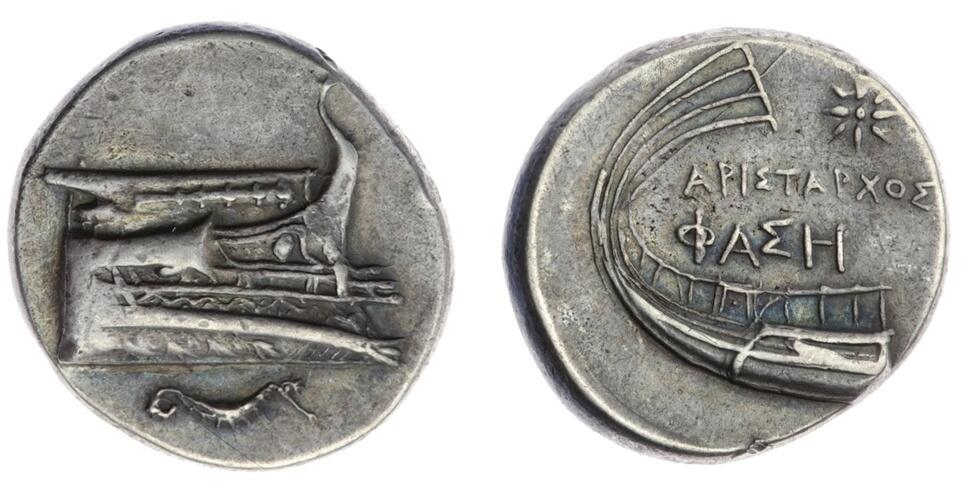Phaselis, silver, staters (prow/stern) (250-220 BCE)
From SILVER
250 BCE - 220 BCE Silver 8,552 kg
Description
| ObverseInscription or printing placed on the obverse.: | Prow of galley right with club right at top of prow, sea horse below. |
| ReverseInscription or printing placed on the reverse.: | ΦΑΣΗ (Greek).Stern of galley left, star and ARISTARCHOS/PHASIS above. |
Mint and issuing power
| MintIdentifies the place of manufacture or issue of a numismatic object.: | Phaselis | Ancient regionAncient region.: | Lycia | Modern countryModern country: Turkey | AuthorityIdentifies the issuing power. The authority can be "pretended" when the name or the portrait of X is on the coin but he/she was not the issuing power. It can also be "uncertain" when there is no mention of X on the coin but he/she was the issuing power according to the historical sources: |
Chronology
| FromIdentifies the initial date in a range assigned in a numismatic context. | 250 BCE | toIdentifies the final date in a range assigned in a numismatic context.. | 220 BCE | PeriodTime period of the numismatic object.: Hellenistic 323-30 BC |
Physical description
| MetalThe physical material (usually metal) from which an object is made.: | Silver |
Median weightMedian of the weights of numismatic objects (in grams). in grams | 10.20 | DenominationTerm indicating the value of a numismatic object. Examples: tetradrachm, chalkous, denarius.: | stater |
StandardStandard.: |
Image

H256 Phaselis stater.jpeg [1]
References
| Die study referencePublication of the study: | Heipp-Tamer 19931Heipp-Tamer 1993, Series 8.2, p. 134-140, n° 83-159. | ||
| Coin series referenceReference to coin series study: | Sear II2Sear II, n° 5332-5336, RQEMH3RQEMH, n° 256 | ||
| Coin series web referenceCoin series web references: | |||
Obverse dies distribution
| FrequencyFrequency of specimen in distribution. ᵖ | Number of obversesNumber of obverse dies. ᵖ (o) | % (o) | Number of coinsNumber of coins. (n) | % (n) | Die nameName(s) of the die(s). |
| 1 | 15 | 42.86 | 15 | 11.9 | 2, 3, 6, 8, 12, 17, 20, 23, 25, 27, 28, 30, 32, 33, 35 |
| 2 | 4 | 11.43 | 8 | 6.35 | 1, 10, 26, 34 |
| 3 | 4 | 11.43 | 12 | 9.52 | 4, 22, 24, 31 |
| 4 | 2 | 5.71 | 8 | 6.35 | 5, 19 |
| 5 | 3 | 8.57 | 15 | 11.9 | 7, 13, 21 |
| 6 | 2 | 5.71 | 12 | 9.52 | 14, 18 |
| 9 | 3 | 8.57 | 27 | 21.43 | 11, 16, 29 |
| 10 | 1 | 2.86 | 10 | 7.94 | 9 |
| 19 | 1 | 2.86 | 19 | 15.08 | 15 |
| Total | 35 of 35 | 100 | 126 of 126 | 99.99 |
Reverse dies distribution
no distribution is available
Quantification
| Number of obversesNumber of obverse dies. ᵖ (o) | 35 | Number of singletons (o1)The number of singleton coins. ᵖ | 15 |
| Number of reverse diesNumber of reverse dies. (r) | 71 | Number of coinsNumber of coins. (n) | 126 |
| Coins per obverse dieNumber of coins per obverse die. (n/o) | 3.6 | Coins per reverse dieNumber of coins per reverse die. (n/r) | 1.77 |
| Reverse per obverse ratioRatio of obverse dies divided by reverse dies. (r/o) | 2.03 | Percentage of singletons (o1)number of coins (n) divided by the number of singletons (o1) ᵖ | 42.86 % |
| Original number of dies (O) (Carter 1983 formula)The estimation of the number of coins according to Carter 1983 ᵖ | 41.92 | Coins struck if 20,000 as average productivity per dieCoins made if the average productivity for obverses (according to Carter) is 20,000. ᵖ | 838,400 |
| Original number of dies (O) (Esty 2011 formula)The estimation of the number of coins according to the singleton formula in Esty 2011 ᵖ (O) | 48.46 | Survival rate if 20,000 as average productivity per dieSurvival rate if average productivity is 20,000. ᵖ | 0.00015 |
| Coverage (o = % of O) (Esty 1984 formula)Esty 1984 - coverage (% of O) ᵖ (o = % of O) | 88.1% | Die productivity if survival rate 1/2,000Average productivity if survival rate is 1/2,000. ᵖ | 6,011.45 |
| Weight of silver (in kg) if 20,000 coins per die (O = Carter formula)Carter 1983 * Median weight * 20000 (*10 if gold or electrum) ᵖ | 8,552 kg <br /> 8,552 kg | Die productivity if survival rate 1/5,000Average productivity if survival rate is 1/5,000. ᵖ | 15,028.63 |
Remarks
Most likely one single workstation Likely military
References
- ^ Heipp-Tamer, Christine (1993), Die Münzprägung der lykischen Stadt Phaselis in griechischer Zeit, Saarbrücken, 182 p., 32 pl.
- ^ Sear, David R. (1979), Greek coins and their values. Vol. II, Asia and North Africa, London, xlviii, p. 317-762
- ^ Callataÿ, François de (1997), Recueil quantitatif des émissions monétaires hellénistiques, Numismatique Romaine, Wetteren, X + 341 p.